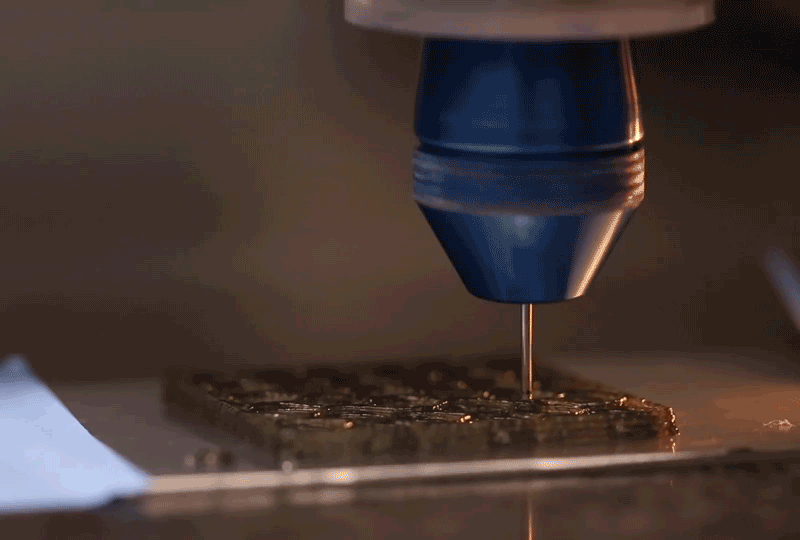
Nature has produced some exquisite composite materials – wood, bone, teeth and shells, for example – that combine light weight and density with desirable mechanical properties such as stiffness, strength and damage tolerance. And since ancient civilizations first combined straw and mud to form bricks, people have fabricated engineered composites of increasing performance and complexity. But reproducing the exceptional mechanical properties and complex microstructures of natural composites in engineered composites has proved challenging.
Now, a team of researchers at the Harvard John A. Paulson School of Engineering and Applied Sciences (SEAS) has demonstrated a novel 3D printing method that yields unprecedented control over the arrangement of short fibers embedded in polymer matrices. They used this additive manufacturing technique to program fiber orientation at specified locations within epoxy composites, creating structural materials optimized for strength, stiffness and damage tolerance.
Their novel method, termed ‘rotational 3D printing’, could have a broad range of applications. Given the modular nature of their ink designs, many different filler and matrix combinations can be implemented to tailor the electrical, optical and thermal properties of the printed objects.
"Being able to locally control fiber orientation within engineered composites has been a grand challenge," said the study's senior author, Jennifer Lewis, professor of biologically inspired engineering at Harvard SEAS. "We can now pattern materials in a hierarchical manner, akin to the way that nature builds." Lewis is also a core faculty member of the Wyss Institute for Biologically Inspired Engineering at Harvard University.
The work, described in a paper in the Proceedings of the National Academy of Sciences, was carried out in the Lewis lab at Harvard. Collaborators included then-postdoctoral fellows Brett Compton (now assistant professor in mechanical engineering at the University of Tennessee, Knoxville) and Jordan Raney (now assistant professor of mechanical engineering and applied Mechanics at the University of Pennsylvania), as well as visiting PhD student Jochen Mueller from ETH Zurich in Switzerland.
The key to their approach is precisely choreographing the speed and rotation of a 3D printer nozzle to control the arrangement of embedded fibers in polymer matrices. This is achieved by equipping a rotational printhead system with a stepper motor to guide the angular velocity of the rotating nozzle as the ink is extruded.
"Rotational 3D printing can be used to achieve optimal, or near optimal, fiber arrangements at every location in the printed part, resulting in higher strength and stiffness with less material," Compton said. "Rather than using magnetic or electric fields to orient fibers, we control the flow of the viscous ink itself to impart the desired fiber orientation."
Compton noted that the team's nozzle concept could be used on any material extrusion printing method, from fused filament fabrication to direct ink writing to large-scale thermoplastic additive manufacturing. It can also be used with any filler material, from carbon and glass fibers to metallic or ceramic whiskers and platelets.
The technique allows for the 3D printing of engineered materials that can be spatially programmed to achieve specific performance goals. For example, the orientation of the fibers can be locally optimized to increase the damage tolerance at locations that would be expected to undergo the highest stress during loading, reinforcing potential failure points.
"One of the exciting things about this work is that it offers a new avenue to produce complex microstructures, and to controllably vary the microstructure from region to region," Raney said. "More control over structure means more control over the resulting properties, which vastly expands the design space that can be exploited to optimize properties further."
"Biological composite materials often have remarkable mechanical properties: high stiffness and strength per unit weight and high toughness. One of the outstanding challenges of designing engineering materials inspired by biological composites is control of fiber orientation at small length scales and at the local level," said Lorna Gibson, professor of materials science and engineering at Massachusetts Institute of Technology, who was not involved in the research. "This remarkable paper from the Lewis group demonstrates a way of doing just that. This represents a huge leap forward in the design of bio-inspired composites."
This story is adapted from material from Harvard SEAS, with editorial changes made by Materials Today. The views expressed in this article do not necessarily represent those of Elsevier. Link to original source.


